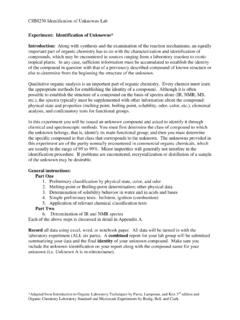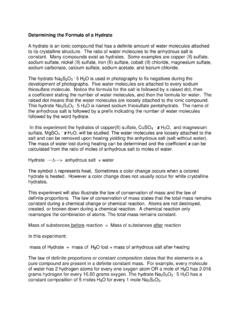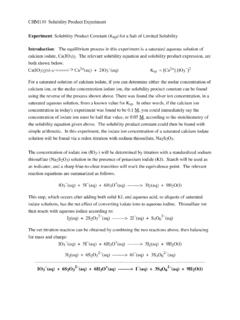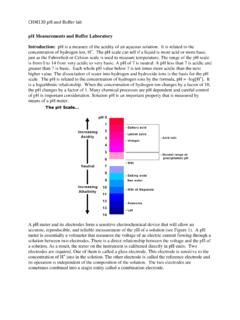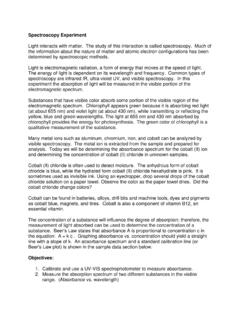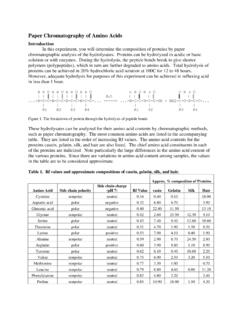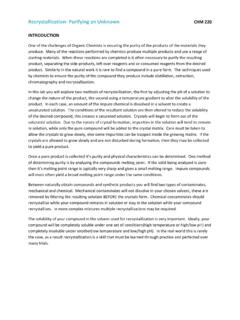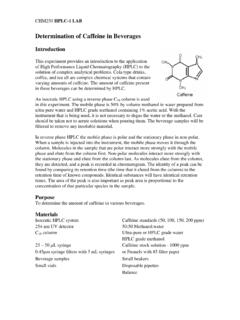Transcription of Experiment: Reactions of alkanes, alkenes, and ...
1 CHM220 Addition lab *Adapted from Experiments for General, organic and Biochemistry, Experiment 24 by Bettelheim and Landesberg Experiment: Reactions of alkanes , alkenes, and cycloalkenes* Purpose: To investigate the physical properties, solubility, and density of some hydrocarbon. To compare the chemical reactivity of an alkane, an alkene, and an aromatic compound. To use physical and chemical properties to identify an unknown. Introduction - Hydrocarbons are the compounds containing only the hydrogen and the carbon elements. The vast number of hydrocarbons is indicative of the number of different ways the carbons skeleton can be arranged. The major uses of hydrocarbons are as fuels and solvents. The properties, which make them ideal for such, will be investigated. The bonding patterns vary with each hydrocarbon family (alkane, alkene, alkyne, aromatic).
2 Because of the number and variety of hydrocarbons that can exist, some means of classification is necessary. One means of classification depends on the way in which carbon atoms are connected. Chain aliphatic hydrocarbons are compounds consisting of carbons linked either in a single chain or in a branched chain. Cyclic hydrocarbons are aliphatic compounds that have carbon atoms linked in a closed polygon (or ring). Another means of classification depends on the type of bonding that exists between carbons. Hydrocarbons that contain only carbon-to-carbon single bonds are called alkanes . These are also referred to as saturated molecules. Hydrocarbons containing at least one carbon-to-carbon double bond are called alkenes, and compounds with at least one carbon-to-carbon triple bond are called alkynes. These compounds are referred to as unsaturated molecules.
3 Finally, a class of cyclic hydrocarbons that contain a closed loop (sextet) of electrons is called aromatic. With so many compounds possible, identification of the bond type is an important step in establishing the molecular structure. Quick, simple tests on small samples can establish the physical and chemical properties of the compounds by class. Some of the observed physical properties of hydrocarbons result from the nonpolar character of the compounds. In general, hydrocarbons do not mix with the polar solvent water. On the other hand, hydrocarbons mix with relatively nonpolar solvents such as ligroin (a mixture of alkanes ), carbon tetrachloride (CCl4), or dichlormethane (CH2Cl2 also known as methylene chloride). Because the density of most hydrocarbons is less than that of water, they will float. 2 | P a g e The chemical reactivity of hydrocarbons is determined by the type of bond in the compound.
4 Although saturated hydrocarbons ( alkanes ) will burn (undergo combustion), they are generally unreactive to most reagents. ( alkanes do undergo a substitution reaction with halogens, but require activation by ultraviolet light to make the reaction proceed). Unsaturated hydrocarbons, alkenes and alkynes, not only burn, but also react by addition of reagents to the double or triple bonds. The addition products are saturated, with fragments of the reagent becoming attached to the carbons of the multiple bond. Aromatic compounds, with a higher carbon-to-hydrogen ratio than nonaromatic compounds, burn with a sooty flame as a result of unburned carbon particles being present. These compounds undergo substitution in the presence of catalysts rather than an addition reaction. Example Reactions : 1. Combustion. The major component in natural gas is the hydrocarbon methane.
5 Other hydrocarbons used for heating or cooking purposes are propane and butane. The products from combustion are carbon dioxide and water with heat being evolved as well. CH4 + 2O2 CO2 + 2H2O + Heat CH3CH2CH3 + 5O2 3CO2 + 4H2O + Heat 2. Reaction with Bromine. Unsaturated hydrocarbons react rapidly with bromine in a solution of carbon tetrachloride or cyclohexane. The reaction is the addition of the elements of bromine to the carbons of the multiple bonds. Alkenes, but not alkanes or aromatic hydrocarbons will react with Br2 in solution to produce the corresponding alkyl bromide (or dibromoalkane). The yellow/orange color of Br2 will disappear as it reacts with the alkenes; the bromoalkane products are usually colorless. Because alkanes have only single C-C bonds present, no reaction with bromine is observed; the red (yellow/orange) color of the reagent would persist when added.
6 CCH3 CCH3 + Br2 Aromatic compounds resist addition reaction because of their aromaticity (the possession of a closed loop (sextet) of electrons). These compounds react with bromine in the presence of a catalyst such as iron filings or aluminum chloride. H+ Br2 Feor AlCl3 Br + HBr CCH3 CCH3 BrBrBrBr3 | P a g e Note that a substitution reaction has taken place and the gas HBr is produced. Iodine (I2) gives a similar reaction and is often used to determine the degree of unsaturation of fats and oils. The amount of unsaturation in fats and oils is often given as the iodine number, which is a related to the amount of iodine consumed by a given amount of fat or oil. 3. Reaction with concentrated sulfuric acid. Alkenes react with cold concentrated sulfuric acid by addition. Alkyl sulfonic acids form as products and are soluble in H2SO4. H3 CCHCHCH3 + HOSO2OH Saturated hydrocarbons are unreactive (additions are not possible); alkynes react slowly and require a catalyst (HgSO4); aromatic compounds also are unreactive because addition Reactions are difficult.
7 4. Baeyers Test: Reaction with Aqueous Potassium Permanganate. Potassium permanganate is an oxidizing agent that reacts with unsaturated aliphatic hydrocarbons, but does not react with alkanes or aromatic hydrocarbons. The dilute KMnO4 solution has a deep purple color; if there is no reaction you should see no color change. When it reacts with unsaturated aliphatics it produces MnO2, a brown precipitate. This reaction is useful as a test for the presence of a multiple bond, if there is no other easily oxidizable group, such as an alcohol or aldehyde. Note that the product formed from an alkene is a glycol. Procedure General instructions: All reagents are available in dropper bottles. Small test tubes (100 x 13 mm) can be used. When mixing components, grip the test tube firmly enough to keep from slipping, but loosely enough to tap it to agitate the contents to mix them.
8 Mix all reagents in the hood. Record all data and observations in the data sheet attached to this document. DISPOSE OF ALL organic WASTES in the hood. DO NOT pour them down the sink. Purple color H3 CHCHCCH3 HOSO2OH4 | P a g e Physical Properties of Hydrocarbons 1. Water solubility of hydrocarbons. Label six test tubes with the name of the substance to be tested. Place into each test tube 5 drops of the appropriate hydrocarbon: hexane, cycohexene, toluene, unknowns A C. Add about 5 drops of water dropwise into each test tube. Is there any separation of components? Which component is on the bottom/top? Mix the contents. What happens when the contents are allowed to settle? What do you conclude about the density of the hydrocarbon? Is the hydrocarbon more or less dense than water? Record your observations on the data sheet. Save these solutions for comparison with the next part.
9 2. Solubility of hydrocarbons in ligroin. Label six test tubes with the name of the substance to be tested. Place into each test tube 5 drops of the appropriate hydrocarbon: hexane, cycohexene, toluene, unknowns A C. Add about 5 drops of ligroin dropwise into each test tube. Ligroin is a nonpolar solvent. Is there any separation of components? Which component is on the bottom/top? Mix the contents. Is there any change in the appearance of the contents before and after mixing? Compare these test tubes with those from the previous part. Record your observations on the data sheet. Chemical Properties of Hydrocarbons 1. Combustion. Place five drops of each hydrocarbon and unknown on separate watch glasses. Carefully ignite each sample with a match. Observe the flame and color of the smoke for each of the samples. Record your observations on the data sheet.
10 2. Reaction with Bromine. Label six clean, dry test tubes with the name of the substance to be tested. Place into each test tube 5 drops of the appropriate hydrocarbon. Carefully add (dropwise and with shaking) 1% bromine in cyclohexane. Keep count of the number of drops needed to have the color persist; DO NOT ADD more than 10 drops. Record your observations. To any sample that gives a negative test after adding 10 drops of bromine solution ( the red color persists), add 5 more drops of the bromine solution and a small quantity of aluminum chloride, the amount on the tip of a micro-spatula; shake the mixture. Hold, with forceps, a piece of moistened blue litmus paper and lower it into the test tube until it is just above the surface of the liquid. Be careful and try not to touch the sides of the test tube or the liquid with the litmus paper. Record any change in the color of the solution and the litmus paper.
